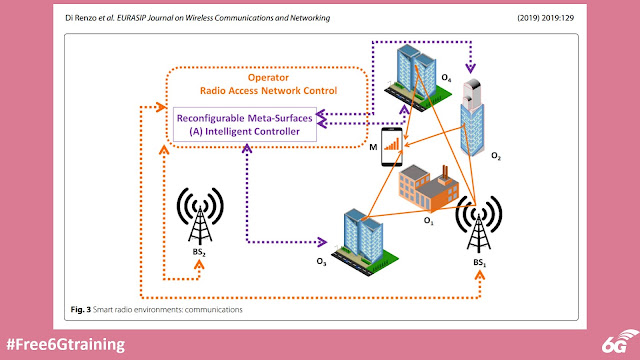We have covered RIS (Reconfigurable Intelligent Surfaces, also known as Intelligent Reflecting Surfaces) quite a few times on this blog but I came across this old paper that I think is worth sharing.
The paper, 'Smart radio environments empowered by reconfigurable AI meta-surfaces: an idea whose time has come' is available as Open Access on Springer Link here. The following is the abstract:
Future wireless networks are expected to constitute a distributed intelligent wireless communications, sensing, and computing platform, which will have the challenging requirement of interconnecting the physical and digital worlds in a seamless and sustainable manner. Currently, two main factors prevent wireless network operators from building such networks: (1) the lack of control of the wireless environment, whose impact on the radio waves cannot be customized, and (2) the current operation of wireless radios, which consume a lot of power because new signals are generated whenever data has to be transmitted.
In this paper, we challenge the usual “more data needs more power and emission of radio waves” status quo, and motivate that future wireless networks necessitate a smart radio environment: a transformative wireless concept, where the environmental objects are coated with artificial thin films of electromagnetic and reconfigurable material (that are referred to as reconfigurable intelligent meta-surfaces), which are capable of sensing the environment and of applying customized transformations to the radio waves.
Smart radio environments have the potential to provide future wireless networks with uninterrupted wireless connectivity, and with the capability of transmitting data without generating new signals but recycling existing radio waves. We will discuss, in particular, two major types of reconfigurable intelligent meta-surfaces applied to wireless networks. The first type of meta-surfaces will be embedded into, e.g., walls, and will be directly controlled by the wireless network operators via a software controller in order to shape the radio waves for, e.g., improving the network coverage. The second type of meta-surfaces will be embedded into objects, e.g., smart t-shirts with sensors for health monitoring, and will backscatter the radio waves generated by cellular base stations in order to report their sensed data to mobile phones.
These functionalities will enable wireless network operators to offer new services without the emission of additional radio waves, but by recycling those already existing for other purposes. This paper overviews the current research efforts on smart radio environments, the enabling technologies to realize them in practice, the need of new communication-theoretic models for their analysis and design, and the long-term and open research issues to be solved towards their massive deployment. In a nutshell, this paper is focused on discussing how the availability of reconfigurable intelligent meta-surfaces will allow wireless network operators to redesign common and well-known network communication paradigms.
The PDF is available here.
Related Posts:
- Free 6G Training: Communications Using Intelligent Reflecting Surfaces in B5G & 6G
- Free 6G Training: '6G Vision for 2030+' from 6th Generation Innovation Centre (6GIC)
- Free 6G Training: Reconfigurable Intelligent Surfaces (RIS) Use Cases
- Free 6G Training: Special Articles on 5G Evolution & 6G in NTT Docomo Technical Journal
- Free 6G Training: Technology Enablers for Spectrum & Energy Efficient 6G Wireless Access
- Free 6G Training: NTT Docomo presents HAPS, Metasurface lens and Pinching antenna at MWC 2021
- 3G4G: 6G Technologies - Introduction from 6G Training
- 3G4G: Free 'An Introduction to 6G' Training Course Online
- 3G4G: 6G and Beyond-5G Wireless Technology


Comments
Post a Comment